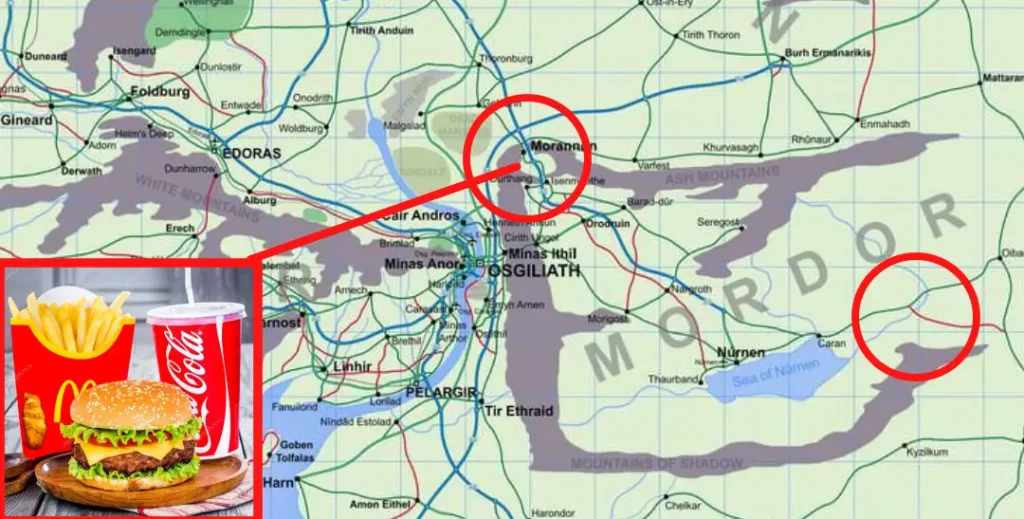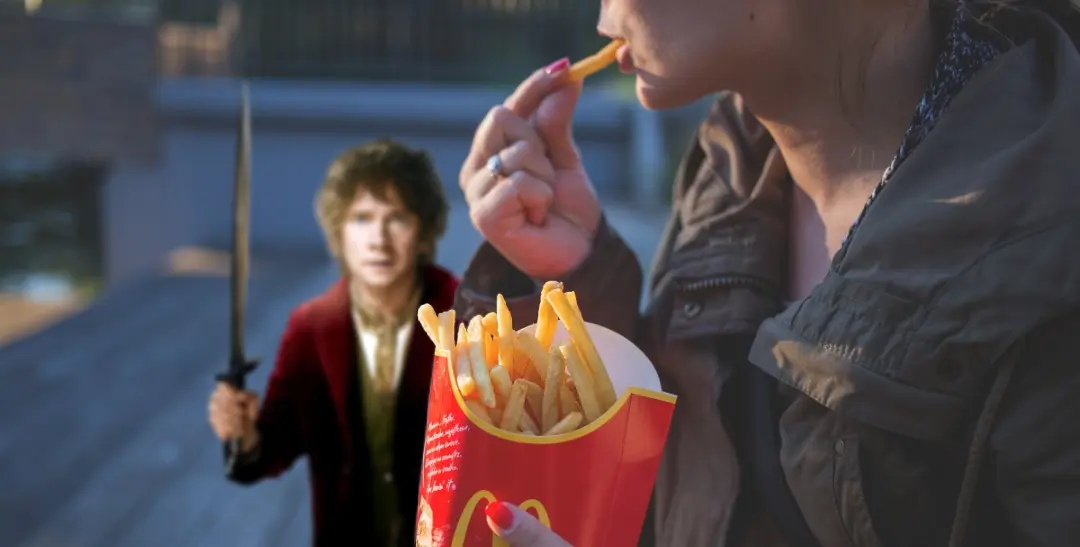McDonald’s. Middle-Earth. There is a correlation here. If you haven’t been paying attention to the news, there is an ongoing crisis in Middle-Earth at the moment where hobbits who move to Mordor are going insane due to the lack of fast food access. Currently, taverns are rationing one meal a day for the local populations, yet they do not accommodate hobbits who need multiple breakfasts, lunches, and dinners.
This has led to the logical question of McDonald’s corporation: Will they take the leap to Middle-Earth and provide the hobbits with food? Is it profitable? Today, we will discuss the technicalities of McDonald’s in Middle-Earth.

FAST FOOD AND THE GEOGRAPHY OF MIDDLE-EARTH
In order to understand if McDonald’s could safely launch a store within the Middle-Earth region, we have to consider the geography of Middle-Earth in relation to the conditions needed for McDonald’s to be established and thrive. Not only does geography need analysis, but the society of Middle-Earth must also be analyzed. This includes but is not limited to, road networks, income, and the addictive qualities of sugar.
One of the most essential things a fast food location must consider before opening is the road networks, as they contain a considerable amount of data regarding potential customers (Duggal, 2007). For example, if a McDonald’s were to open on the side of a highway without considering road networks, it may find that the highway is rarely used during 8:00 a.m., 12:00 p.m., and 5:00 p.m., hours that are crucial to a restaurant that hopes to maintain profits.
Looking at Mordor’s road networks, the public has only been given access to the general map. Despite there being no data connected, it can be seen that there are only two points of access to Mordor. One is via the main entrance of Morannon, while the other point of access is behind the mountains and through the route of Caran. Since most villages’ main access point to Mordor is via Morannon, most traffic would be located there. Through this access point, McDonalds could secure customers from outside and inside Mordor.
While this location is ideal, another factor is at play here. Various studies, specifically one conducted by Fraser and Lorna in 2010, found a correlation between fast food restaurants being established in low-income areas. Having recently been burnt to the ground during the Ring Incident and is collectively rebuilding, Mordor is considered a relatively low-income place. With little money generated by its inhabitants, trips to the local vendors become more expensive than a Big Mac meal.
Addictions are the last factor that McDonald’s would have to consider before launching a campaign in Middle-Earth. As of 2025, there has been no solid evidence of humans being addicted to fast food, though certain ingredients within fast food can be addictive. Sugar, while also inconclusive whether or not it is an addiction to humans, was found to be addictive to rats (Garber, Andrea, Lustig, 2011). A hobbit is neither a human nor a rat but a different creature altogether. No study has been conducted on hobbits and their relationship with sugar; it can be assumed that some rely on it just as humans do.
However, there is an additional factor in food addiction that can be devastating for hobbits but increase McDonald’s revenue. Regular fast food consumption can lead to a buildup of resistance to insulin, leptin, and other hormonal signals that help a human’s body regulate its food intake levels (Garber, Andrea, Lustig, 2011). hobbits already have a problem with their intake levels, requiring multiple breakfasts to keep their appetite content.
As McDonald’s continues to expand across the globe and possibly other areas such as Middle-Earth, it has been found that going to fast food restaurants has become somewhat of a family ritual (Hoff-Jørgensen & Leer, 2025). Not only could McDonald’s exploit the already hungry hobbits, but opening a restaurant could result in new social norms shaking up hobbit culture.

THE MORALITY OF THE SITUATION AND IT’S CONCLUSION
In conclusion, a McDonald’s franchise beginning in Mordor would generate a fair amount of revenue, about the same as it would in the United States. However, as time progressed and advertising was spent on hobbit communities, it would soon grow at a dangerous rate. While this would provide hobbits with more jobs in the surrounding area, it could negatively affect their family habits. Morally speaking, it would be more proper for McDonalds to begin incorporating healthier meals and less addictive ingredients to better support hobbit’s digestive system.
WORKS CITED
Duggal, H. (2007). Retail Location Analysis: A Case Study of Burger King & McDonald’s in Portage & Summit Counties, Ohio. Weekly Releases (1997–2007), 12(36). https://doi.org/10.2807/esw.12.36.03264-en
Fraser, L. K., Edwards, K. L., Cade, J., & Clarke, G. P. (2010). The Geography of Fast Food Outlets: A Review. International Journal of Environmental Research and Public Health, 7(5), 2290–2308. https://doi.org/10.3390/ijerph7052290
Hoff-Jørgensen, C., & Leer, J. (2025). Disgust, Pleasure, and Convenience in fast-food consumption: Perspectives from Danish Middle-Class Parents. Appetite, 107858. https://doi.org/10.1016/j.appet.2025.107858
K. Garber, A., & H. Lustig, R. (2011). Is Fast Food Addictive? Www.ingentaconnect.com. https://www.ingentaconnect.com/content/ben/cdar/2011/00000004/00000003/art00004
